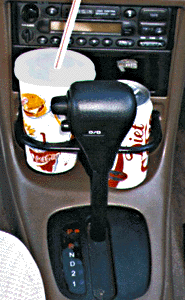About Design
We live surrounded by tons of products that are no longer ordinary or inactives. Most of them are interactive and because we are so used to them, we are not conscious in what manner they contribute to our daily live. Those devices I'm talking about are mobile phones, personal computers, coffee machines, printers, videogames, just to list a few of them.
The important question here is: How many are easy to use and enjoyable without making a huge effort?
Of course, this is pretty easy to answer and the list will be quite small!
Sometimes we end up hammering our heads against the wall because we are not able to complete the desired task with this product.
Why this happens?
The answer is because some products were not designed with the user in mind.
The aim of interaction design is to solve these kind of issues bringing usability to the design process. That is, developing products that are easy, effective, and enjoyable to use from the user perspective.
A good way to start thinking when a product has a good or bad interactive design is explore some examples that reflect the concept we are looking for.
In this coffee machine after inserting the coins in the slot you have to select your coffee bean. So, you press the rectangular labels to select your coffee but...they are not buttons! Probably you might think this because of Coke Can Machines work that way but...these ones not. Mmm...this is really working? Lets press the + or - sign that supposedly controls the amount of sugar...Wait WHAT? they are not buttons! After 10 minutes standing at the machine you can distinguish BLACK rounded buttons with BLACK background. Clearly a bad design!
The guy who came up with this amazing design should be in prison right now. In fact, a friend used to have this keyboard. I never was able to use it. Every time I wrote something, suddenly the computer shut down unexpectedly...My friend always said to me "you probably has pressed the shut down key". Nice...thanks for the two hours I have sent to the trash. Terrible design!
Design Phase:
The important question here is: How many are easy to use and enjoyable without making a huge effort?
Of course, this is pretty easy to answer and the list will be quite small!
Sometimes we end up hammering our heads against the wall because we are not able to complete the desired task with this product.
Why this happens?
The answer is because some products were not designed with the user in mind.
The aim of interaction design is to solve these kind of issues bringing usability to the design process. That is, developing products that are easy, effective, and enjoyable to use from the user perspective.
Good Design vs Poor Design
 |
| Hitting the radio |
Why I cannot use the radio while carrying my beverages?
 |
| Coffee Machine |
 |
| Keyboard Layout |
Thinking in What, Why and How
Suppose you have to design a new software product what would you do?
Start coding in a frenzy way until you are done with? Studying the characteristics of a well known similar software? Asking your end users about their experience, their problems, studying their tools and based on this start thinking about the what, why and how to design it? Probably the best approach would be the latter one. One of the main advantages is that you will definitely save money, time and effort.
Conceptual Models
A good way to better understanding the problem domain is to develop conceptual models. By conceptual models we mean a description of the proposed system in terms of ideas and concepts about what it should do and look like also being understandable by the users.
Developing conceptual models helps to envision the future product based on the user's needs and other requirements identified. As the product is being developed it is highly advisable to do iterative testing to ensure that it is designed to be understandable in the way that was planned. A key aspect in the design process is to identify what tasks the user will be doing when using the product. As with any aspect of interaction design, the process of filtering or cleaning the conceptual
models should be done iteratively, using different methods such as sketching ideas, storyboards, brainstorming sessions (or visual brainstorming), describing scenarios (like "stories") and prototyping
aspects of how the system works.
Norman's Framework (1988)
One of the most important activities while developing a conceptual model is to determine if the users will understand the system in the manner intended. Norman presented a framework to make the relationship between the design of a conceptual model and the user's understanding be clearer.
Jacob Nielsen wrote a blogpost explains a little bit what Mental Models are. In it, he says that mental models are "based on belief, not facts: that is, it's a model of what users know (or think they know) about a system such as your website". This definition brings to the light the discrepancies that Norman's Framework want to iron out. Also, "Metal Models" by Indi Young states that "metal models give you a deep understanding of people’s motivations and thought-processes, along with the emotional and philosophical landscape in which they are operating". Moreover, the author highlight the importance that these kind of models have. She summary this idea in the "three C's":
Pabini Gabriel-Petit, a professional with more than 20 years of experience in User Experience and Design, in an article at uxmatter.com wrote that in the goal for achieving optimal design solutions, designers need an effective process that provides a framework to work with to deliver high quality work.
This should be a user-centered design (UCD) process, but also being a flexible process. She came up with UC3D Lifecycle that comprises three phases: Discovery, Design, and Development Support.
The UC3D can be summarised in the following steps:
Discovery Phase:
 |
| Norman Framework |
In this framework we can distinguish three different components:
- the Design Model represents how the system should work,
- the System Image represents how the system actually works
- the User's Model represents how he thinks the system works.
Jacob Nielsen wrote a blogpost explains a little bit what Mental Models are. In it, he says that mental models are "based on belief, not facts: that is, it's a model of what users know (or think they know) about a system such as your website". This definition brings to the light the discrepancies that Norman's Framework want to iron out. Also, "Metal Models" by Indi Young states that "metal models give you a deep understanding of people’s motivations and thought-processes, along with the emotional and philosophical landscape in which they are operating". Moreover, the author highlight the importance that these kind of models have. She summary this idea in the "three C's":
- Confidence - guide the decision of the solution,
- Clarity - make good user and business decisions,
- Continuity - ensure longevity of vision and opportunity.
The Process of Design
Pabini Gabriel-Petit, a professional with more than 20 years of experience in User Experience and Design, in an article at uxmatter.com wrote that in the goal for achieving optimal design solutions, designers need an effective process that provides a framework to work with to deliver high quality work.
This should be a user-centered design (UCD) process, but also being a flexible process. She came up with UC3D Lifecycle that comprises three phases: Discovery, Design, and Development Support.
 |
| UC3D Lifecycle - from uxmatters.com |
Discovery Phase:
- Learning about your users
- Modelling your users (like using model personas)
- Analysing your user's tasks
- Eliciting and Defining Clear Product Requirements
Design Phase:
- Developing Conceptual Models
- Solving Key Design Problems Through Ideation
- Doing Detailed Design
Development Support:
- Providing Development Support
Your iterative process of design refinement should continue throughout product development as developers discover they need additional design details. All doubts that may arise should be answered by the working team to the people in charge of the development, and clarify design artifacts as necessary.
Also at this stage, if the testing reveals usability problems or usability issues you will need to do recheck your design solutions and artifacts. However, most of the usability issues you discover at this step are not addressed until the next product release. The Development Support Phase ends with the delivery of the (supposedly) high quality product that meets user's needs and is easy to learn and use.

Comments